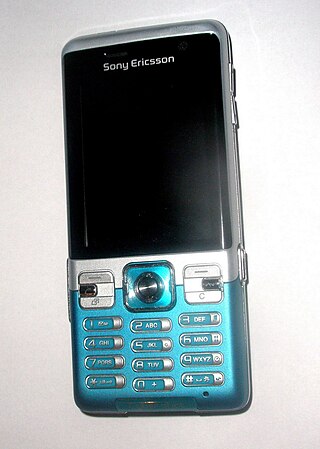
Telefonaktiebolaget LM Ericsson, commonly known as Ericsson, is a Swedish multinational networking and telecommunications company headquartered in Stockholm. The company sells infrastructure, software, and services in information and communications technology for telecommunications service providers and enterprises, including, among others, 3G, 4G, and 5G equipment, and Internet Protocol (IP) and optical transport systems. The company employs around 100,000 people and operates in more than 180 countries. Ericsson has over 57,000 granted patents.
The Universal Mobile Telecommunications System (UMTS) is a third generation mobile cellular system for networks based on the GSM standard. Developed and maintained by the 3GPP, UMTS is a component of the International Telecommunication Union IMT-2000 standard set and compares with the CDMA2000 standard set for networks based on the competing cdmaOne technology. UMTS uses wideband code-division multiple access (W-CDMA) radio access technology to offer greater spectral efficiency and bandwidth to mobile network operators.
Sony Mobile Communications Inc. was a multinational telecommunications company founded on October 1, 2001, as a joint venture between Sony Corporation and Ericsson. It was originally incorporated as Sony Ericsson Mobile Communications, and headquartered in London, England, until Sony acquired Ericsson's share in the venture on February 16, 2012. On April 1, 2021, Sony integrated its electronics businesses including Sony Mobile into one company called Sony Corporation.

The history of mobile phones covers mobile communication devices that connect wirelessly to the public switched telephone network.

Sony Ericsson M600 is a 3G smartphone based upon the UIQ 3 platform. It was announced on February 6, 2006 and is the first and only product of the M series of handsets from Sony Ericsson.
Generic Access Network (GAN) is a protocol that extends mobile voice, data and multimedia applications over IP networks. Unlicensed Mobile Access (UMA) is the commercial name used by mobile carriers for external IP access into their core networks. The latest generation system is named Wi-Fi calling or VoWiFi by a number of handset manufacturers, including Apple and Samsung, a move that is being mirrored by carriers like T-Mobile US and Vodafone. The service is dependent on IMS, IPsec, IWLAN and ePDG.
Yettel Serbia is a Serbian mobile, fixed, internet and IPTV provider, owned by the Czech investment group PPF. It is headquartered in Belgrade. As of 2020, it is the second largest mobile telephony operator with market share of 36.98%.

The Sony Ericsson K850i is a high-end mobile phone when released in October 2007. It was announced in June 2007 as the flagship product in Sony Ericsson's K ("Kamera") series, with a 5 megapixel CMOS camera sensor. The K850 was the first Sony Ericsson phone released outside of NTT DoCoMo to support microSD and microSDHC along with Sony's traditional M2. It also introduces the usage of three touch-sensitive softkeys right under the display and a new form of navigation button, omitting the classic joystick introduced with the Ericsson T68. The camera interface has been revamped to resemble the format of cybershot digital cameras. According to the manufacturer the UMTS talk time has been significantly increased to 3 hours 30 min over its predecessor, the K800 and K810.. It was Sony Ericsson's first 3.5G HSDPA supporting mobile phone, and was also the first 3G "global" mobile with supporting all major operating network frequency in the world including GSM 850, GSM 900, GSM 1800, GSM 1900, HSDPA, UMTS 850, UMTS 1900, UMTS 2100.

The Xperia X1 is a high-end smartphone from Sony Ericsson, and is the first in the manufacturer's Xperia series. The phone was designed and built by Taiwanese OEM HTC. The X1 was first presented at the 2008 Mobile World Congress.

3 (Three), also known as Hutchison 3G, is a global brand name owned by Hutchison 3G Enterprises S.A.R.L., under which several UMTS-based mobile phone networks and broadband Internet providers operate in Hong Kong, Macau, Austria, Denmark, Indonesia, Ireland, Italy, Sweden, and the United Kingdom.

The Symbian Foundation was a non-profit organisation that stewarded the Symbian operating system for mobile phones which previously had been owned and licensed by Symbian Ltd. Symbian Foundation never directly developed the platform, but evangelised, co-ordinated and ensured compatibility. It also provided key services to its members and the community such as collecting, building and distributing Symbian source code. During its time it competed against the Open Handset Alliance and the LiMo Foundation.

Sony Ericsson C702 is a mobile phone handset manufactured by Sony Ericsson. The phone features a 3.2-megapixel digital camera with LED flash and a few features such as geo-tagging and face detection. On the entertainment front, the phone has a media player supporting MP3, AAC/AAC+/eAAC+ and WMA music files and 3GP/MPEG-4 video files. The phone also features a RDS FM radio, and a Memory Stick Micro (M2) slot for expandable solid state memory
ST-Ericsson was a multinational manufacturer of wireless products and semiconductors, supplying to mobile device manufacturers. ST-Ericsson was a 50/50 joint venture of Ericsson and STMicroelectronics established on 3 February 2009 and dissolved 2 August 2013. Headquartered in Geneva, Switzerland, it was a fabless company, outsourcing semiconductor manufacturing to foundry companies.

Samsung GT-i8910 Omnia HD is a smartphone manufactured by Samsung Electronics, first announced at MWC 2009 on February 18, 2009. The device was the first phone capable of playing and recording 720p HD video. It runs on the S60 5th Edition (Symbian^1) platform, the only Samsung device to do so.

The Japanese mobile phone industry is one of the most advanced in the world. As of March, 2022 there were 199.99 million mobile contracts in Japan according to the Ministry of Internal Affairs and Communications. This is 158 percent of Japan's total population.

The Sony Ericsson Xperia arc S is a high-end smartphone developed by Sony Ericsson running Google's operating system Android 2.3.4 (Gingerbread). It is an upgraded version of the Sony Xperia Arc. It is the last phone carrying the Sony Ericsson brand, before Sony bought Ericsson's stake in the joint-venture.

Ericsson Mobile Communications AB was a subsidiary of Ericsson, entirely focused on development of mobile phones (handsets). The major offices were located in Lund, Kumla, Raleigh, North Carolina and Lynchburg, Virginia.

Ericsson Radio Systems AB was the name of a wholly owned subsidiary in the Ericsson sphere, founded January 1, 1983 by buying out all former owners of Svenska Radioaktiebolaget (SRA). The company was well known in Scandinavia and elsewhere in the 1980s, as it was deploying NMT systems and developing a line of mobile telephones under the brand name Hotline. In 2002 the subsidiary changed its name to simply Ericsson AB and absorbed 19 other legal entities in the Ericsson sphere, but kept its company registration number with the Swedish state, so it is still the same legal entity as Ericsson Radio Systems. The merge of the smaller legal entities was done to cut down operating costs. The main activity within Ericsson AB is infrastructure for mobile telephony.

The Samsung SGH-U900 is a slider mobile phone from Samsung Telecommunications. It was introduced at Mobile World Congress on 11 February 2008. It is a member of Samsung's fashion-focused "Ultra" line of handsets and the company's flagship at the time.
Tord Wingren is a Swedish inventor, entrepreneur, and scientist and holder of 28 patents relating to wireless communication, technology, and the implications of light on the human body. He developed Bluetooth technology while working with Ericsson Mobile Communications, and is the co-founder of several technology companies including BrainLit, Watersprint, and Modcam AB.












